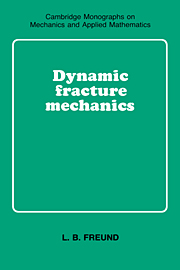Book contents
- Frontmatter
- Contents
- Preface
- List of symbols
- 1 Background and overview
- 2 Basic elastodynamic solutions for a stationary crack
- 3 Further results for a stationary crack
- 4 Asymptotic fields near a moving crack tip
- 5 Energy concepts in dynamic fracture
- 6 Elastic crack growth at constant speed
- 7 Elastic crack growth at nonuniform speed
- 8 Plasticity and rate effects during crack growth
- Bibliography
- Index
1 - Background and overview
Published online by Cambridge University Press: 03 October 2009
- Frontmatter
- Contents
- Preface
- List of symbols
- 1 Background and overview
- 2 Basic elastodynamic solutions for a stationary crack
- 3 Further results for a stationary crack
- 4 Asymptotic fields near a moving crack tip
- 5 Energy concepts in dynamic fracture
- 6 Elastic crack growth at constant speed
- 7 Elastic crack growth at nonuniform speed
- 8 Plasticity and rate effects during crack growth
- Bibliography
- Index
Summary
Introduction
The field of fracture mechanics is concerned with the quantitative description of the mechanical state of a deformable body containing a crack or cracks, with a view toward characterizing and measuring the resistance of materials to crack growth. The process of describing the mechanical state of a particular system is tantamount to devising a mathematical model of it, and then drawing inferences from the model by applying methods of mathematical or numerical analysis. The mathematical model typically consists of an idealized description of the geometrical configuration of the deforriiable body, an empirical relationship between internal stress and deformation, and the pertinent balance laws of physics dealing with mechanical quantities. For a given physical system, modeling can usually be done at different levels of sophistication and detail. For example, a particular material may be idealized as being elastic for some purposes but elastic-plastic for other purposes, or a particular body may be idealized as a one-dimensional structure in one case but as a three-dimensional structure in another case. It should be noted that the results of most significance for the field have not always been derived from the most sophisticated and detailed models.
A question of central importance in the development of a fracture mechanics theory is the following. Is there any particular feature of the mechanical state of a cracked solid that can be interpreted as a “driving force” acting on the crack, that is, an effect that is correlated with a tendency for the crack to extend?
Information
- Type
- Chapter
- Information
- Dynamic Fracture Mechanics , pp. 1 - 54Publisher: Cambridge University PressPrint publication year: 1990
